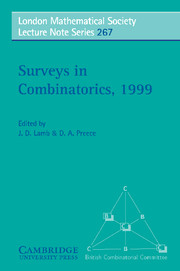Book contents
- Frontmatter
- Contents
- Preface
- The Rado Lecture
- The Invited Lectures
- Polynomials in Finite Geometries
- Applications of Combinatorial Designs to Communications, Cryptography, and Networking
- Random Walks on Combinatorial Objects
- Bose–Burton Type Theorems for Finite Projective, Affine and Polar Spaces
- Geometric Graph Theory
- Recent Excluded Minor Theorems for Graphs
- Parity, Cycle Space, and K4-Subdivisions in Graphs
Parity, Cycle Space, and K4-Subdivisions in Graphs
Published online by Cambridge University Press: 05 May 2013
- Frontmatter
- Contents
- Preface
- The Rado Lecture
- The Invited Lectures
- Polynomials in Finite Geometries
- Applications of Combinatorial Designs to Communications, Cryptography, and Networking
- Random Walks on Combinatorial Objects
- Bose–Burton Type Theorems for Finite Projective, Affine and Polar Spaces
- Geometric Graph Theory
- Recent Excluded Minor Theorems for Graphs
- Parity, Cycle Space, and K4-Subdivisions in Graphs
Summary
Summary We survey some parity arguments and problems in graph theory, in particular some that can be attacked using the cycle space of a graph. We discuss some results on specific collections of cycles that generate the cycle space. We explain how the space generated by the cycles through two prescribed edges in a graph is used in a proof of the conjecture made by B. Toft in 1974 that every 4-chromatic graph contains a totally odd K4-subdivision, that is, a subdivision of K4 in which each edge of K4 corresponds to an odd path. (Another proof of Toft's conjecture was found independently by W. Zang). We prove the new result that every 4-connected graph with at least three triangles contains a totally odd K4-subdivision if and only if it does not contain a vertex whose deletion results in a bipartite graph. In particular, every 4-connected planar graph contains a totally odd K4-subdivision. Finally, we offer some conjectures on path systems and subdivisions with parity constraints on the lengths.
Introduction
Parity arguments are often both elegant and powerful. An early parity result in graph theory is Redei's theorem [12] saying that the number of directed Hamiltonian paths in any tournament is odd. It implies, in particular, that every tournament has a directed Hamiltonian path. While this is an easy exercise, Redei's theorem inspired Forcade [4] to a parity result where the corresponding existence result is highly nontrivial.
Information
- Type
- Chapter
- Information
- Surveys in Combinatorics, 1999 , pp. 223 - 238Publisher: Cambridge University PressPrint publication year: 1999
Accessibility standard: Unknown
Why this information is here
This section outlines the accessibility features of this content - including support for screen readers, full keyboard navigation and high-contrast display options. This may not be relevant for you.Accessibility Information
- 1
- Cited by
